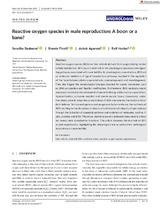| dc.description.abstract | Reactive oxygen species (ROS) are free radicals derived from oxygen during normal cellular metabolism. ROS play a crucial role in the physiological processes and signalling pathways associated with male fertility. At physiological concentrations, ROS act as molecular mediators of signal transduction pathways involved in the regulation of the hypothalamic–pituitary–gonadal axis, spermatogenesis and steroidogenesis. They also trigger the morphological changes required for sperm maturation, such as DNA compaction and flagellar modification. Furthermore, ROS modulate crucial processes involved in the attainment of sperm fertilising ability such as capacitation, hyperactivation, acrosome reaction and sperm–oocyte fusion. Conversely, oxidative stress prevails when the concentration of ROS overwhelms the body's antioxidant defence. Various endogenous and exogenous factors enhance the synthesis of ROS resulting in the disruption of structural and functional integrity of spermatozoa through the induction of apoptotic pathway and oxidation of molecules, such as lipids, proteins and DNA. | en_US |

